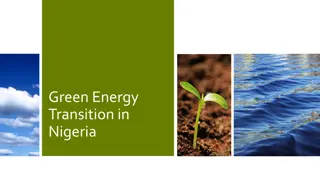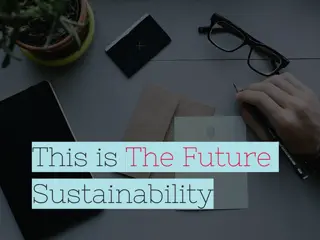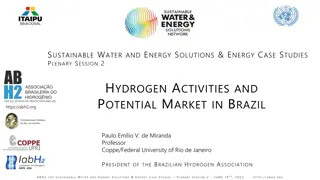Renewable Energy Lab: Exploring Solar, Wind, and Hydrogen Technologies
Explore the capabilities of solar panels, wind turbines, hydrogen fuel cells, and capacitors in this Renewable Energy Lab. Learn about the harnessed clean energy sources, including solar panels converting sunlight to electricity and wind turbine technology utilizing wind pressure. Design a renewable energy car for a friendly competition among groups and discover the vast potential of renewable energy sources.
Download Presentation

Please find below an Image/Link to download the presentation.
The content on the website is provided AS IS for your information and personal use only. It may not be sold, licensed, or shared on other websites without obtaining consent from the author.If you encounter any issues during the download, it is possible that the publisher has removed the file from their server.
You are allowed to download the files provided on this website for personal or commercial use, subject to the condition that they are used lawfully. All files are the property of their respective owners.
The content on the website is provided AS IS for your information and personal use only. It may not be sold, licensed, or shared on other websites without obtaining consent from the author.
E N D
Presentation Transcript
EG1003: Introduction to Engineering and Design Renewable Energy Lab
Overview Experimental Objective Background Information Materials Procedure Assignment Conclusion
Experimental Objective Test the capabilities of solar panels and wind turbines Test the capabilities of the hydrogen fuel cells and capacitors Design a renewable energy car to compete against the other groups
Background Information Renewable Energy Solar panels Wind-turbine technology Hydrogen fuel cells Electronic Components
Renewable Energy Harnessed from nature resources Clean energy sources Sources for energy are abundant in supply[1]
Solar Panels Made from silicon or copper indium gallium (di)selenide (CIGS) Converts Sunlight to electrical current Absorbed sunlight excites electrons to allow freedom of motion (generates an electric current)[2]
Wind-turbine technology Use pressure difference generated by the wind to spin the turbine blades Converts mechanical energy into electrical energy The wind vane (10) is use to determine the direction the wind-turbine will face[3]
Hydrogen Fuel Cells Stores chemical energy and converts it into electrical energy Types of fuels used includes (but not limited to) hydrogen, methane, and gasoline Reversible fuel cells can separate water into hydrogen and oxygen, then use it to generate electrical energy [4]
Electronic Components A capacitor is an electrical device used to store charge Capacitors can be connected in parallel (increases charge stored) and in series (increases voltage stored)[5]
Competition Rules Power storage devices must be contained in the car The only power sources allowed are the wind- turbine and solar panel The renewable energy car may not be pushed or launched The renewable energy car should not be touched after it has started to move The car will run for up to two minutes or until the car comes to a stop
Materials Horizon Wind-Turbine Solar Battery Panels Adjustable Table fan Heat Lamp DMM (Digital Multi-meter) Music Voltmeter 2V DC Motor Horizon Hydrogen Fuel cell 1 Farad 2.5V Capacitor Mini Electric propeller LED (Light Emitting Diode) Alligator cable sets Standard Lego Car Chassis plus Lego parts kit Lego to Alligator Cable Clip Connector Scissors Tape
Materials Price List Horizon Wind-Turbine ($5.00/each) Solar Battery Panels ($10.00/each) Horizon Hydrogen Fuel cell ($12.00/each) 1 Farad 2.5V Capacitor ($3.00/each) Alligator cable sets ($0.50/each pair) Standard Lego Car Chassis plus Lego parts kit (only one kit) Lego to Alligator Cable Clip Connector ($0.10/each) Tape ($0.10/feet)
Procedure Part 1:Test the Power sources using music voltmeter Solar panel Wind-turbine Part 2: Test the power storage devices Hydrogen fuel cell Capacitor Part 3: Design a renewable energy car using the power sources and power storage devices of your choice
Procedure Here is an inspiration for your design!
Assignment: Report Individual Lab Reports Title page Discussion of topics in the manual Include original data with instructor s initials Scan in lab notes (ask TA for assistance) TA must initial that table and graph were completed
Assignment: Presentation Team presentation State rules of competition Describe your design and its concepts Include table of class results, cost and photo/video of design How could your current design be improved? Refer to Creating PowerPoint Presentations found on EG website
Closing Have all original data signed by TA Submit all work electronically Clean up workstations Return all materials to TA
Works Cited Eriksson, J.. "Renewable energy vs. fossil fuel." Renewable power news. N.p., 2010. Web. 26 Jul 2012. <http://www.renewablepowernews.com/archives/1413>. [1] http://www.agc-flatglass.com/AGC-Flat-Glass/English/Other/News-Overview/News- Detail/page.aspx/1014?newsitem=1273[2] . The structure of a modern wind turbine an overview. N.p., n.d. Web. 26 Jul 2012. <http://www.wwindea.org/technology/ch01/en/1_2.html>. [3] Reg Tyler, . "Types of Fuel Cells." Energy efficeny and renewable energy. U.S. Department of Energy, 2011. Web. 24 Jul 2012. <http://www1.eere.energy.gov/hydrogenandfuelcells/fuelcells/fc_types.html>. [4] . Rotational Equilibrium. WWU, n.d. Web. 26 Jul 2012. <http://faculty.wwu.edu/vawter/PhysicsNet/Topics/TopicsMainTemplate.html>. [5] http://www.horizonfuelcell.com/files/Education_Series_PDF.pdf[6]























